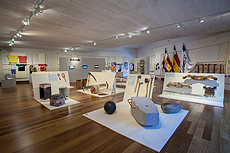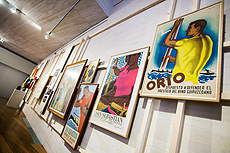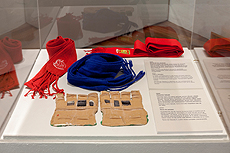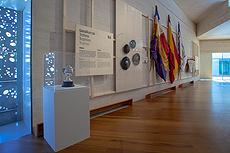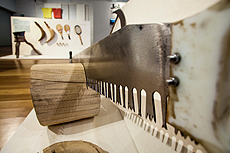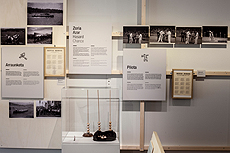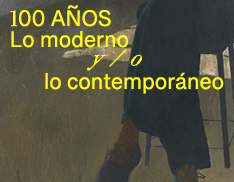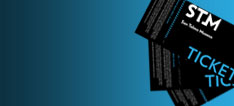- Home
- Exhibitions
- Temporary exhibitions
Jokoak. Material and Challenge
|
|
"Jokoak (Games) Material and Challenge" enters the Basque sporting universe through pelota, rowing, stone-lifting, wood-chopping, grass-mowing and stone-dragging. It shows images, audiovisual content, tools and personal objects belonging to its protagonists: the oar belonging to the legendary Aita Manuel, the racquet belonging to Agustina Otaola, the 329-kg stone belonging to Saralegi, Araria II's axe and Atano III's beret.
- From 8 July to 16 October 2016
- Tuesday to Sunday, from 10:00 to 20:00 (open Monday 25/07 and 15/08)
- Free entry
- #STMJokoak
More pictures: Jokoak. Material and Challenge album on Flickr.
Jokoak (Games) Material and Challenge enters the Basque sporting universe through six of its most representative games: pelota, rowing, stone-lifting, wood-chopping, grass-mowing and stone-dragging. It shows tools and personal objects belonging to protagonists and traces a route in images through some of the themes shared by these sports: challenge, rivalry, triumph, spectators and the village square. The exhibition aims to investigate and interpret the reasons why these sports are the way they are.
In the exhibition area called Agon-Desafío (Challenge) subjects such as clothing and equipment, rules and the drawing of lots, and challenges are covered.
Linked to the protagonists of these sports, the exhibition analyses the quality of strength in sport, and its antagonist, cunning, as the two opposites represented among the protagonists. It also includes the figure of the plaza-gizon, and the displaced bodies: women, who have not been granted the relevance or recognition men have enjoyed in these sports.
The section entitled La Plaza-Agora is devoted to the Basque village square which, like the agora in Greece, provides the stage for agonistic battles (in this case, the game) and great clashes, keeping them under the control and authority of the public.
The sportsmen and women are acclaimed when they win the favour of the public and when they achieve triumphs and trophies. Berets, flags, blankets... these are the most sought-after trophies, and the exhibition gathers a significant collection of the most legendary examples.
The purpose is also to encourage some thought regarding the matter of non-segregation of the sexes in sporting participation. The exhibition shows activities in which men and women play together. It serves as a closure for an exhibition that revolves around the idea of equal opportunities.
Objects belonging to protagonists
These are some of the sportspeople who have contributed their objects to the exhibition: Aimar Olaizola, Juan Martinez de Irujo, Florentino Sagarzazu, Joxe Garate, Miguel Gallastegi, Mieltxo Saralegi, Goenatxo II, Iñaki Osa Goikoetxea, Aita Manuel, Atano III, Mikel Urrutikoetxea, Iker Irribarria, Arria III, Arria II, Miguel Mindegia, Joxe Mari Olasagasti, Izeta II, Agerre II, Iñaki Lopetegi, Agustina Otaola, Maite Ruiz de Larramendi, Jesus Abrego, Konpa, Alazne Etxaburua, Aita Manuel, Jose Luis Korta, Igor Esnaola, Xanti Aizpurua,San Pedro Rowing Club Orio Rowing Club, San Juan Rowing Club, Donostiarra Rowing Club.
Anthropological approach to Basque sport
The exhibition takes an anthropological approach to Basque sport and it revolves around two fundamental axes: materiality and challenge. The first of these axes presents the objects and tools that make up the material culture of these sports. Stones, axes, oars, balls, racquets, flags, gerrikos (belts) and shirts, among other items, provide a way in to a world whose aesthetic force resides in the simplicity of its shapes and materials, but which hides an entire gathering of knowledge, meanings and cultural loans. That material is grouped and shown in the middle of the exhibition.
The second axis, shown at the perimeter of the exhibition, links the competitive game, the joko, to the foundation of the community, centred on the town or village square. The intimate relation between the agon and the agora serves to build a narrative which seeks to induce reflections around some of the characteristics of these sports and, by extension, Basque culture and society.
Organised by: STM
Thesis and discourse of the exhibition: Olatz Gonzalez Abrisketa
Thesis and discourse of the exhibition
WEB HEADER:
PAGE FOOTER:
Auxiliary menu:
San Telmo Museoa. 2024 copyright ©
HELP WHIT SURFING:
